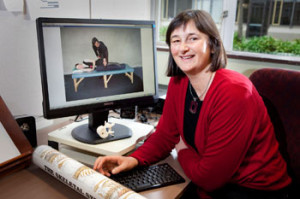Spinal cord injuries research a world first
In the 1940s, Israeli physicist Dr Moshe Feldenkrais combined his knowledge of martial arts, biomechanics, neurophysiology, anatomy, learning theory, child development, systems theory, physics and psychology to develop the Feldenkrais Method, a form of sensory motor education. Research has provided evidence of benefits including reduced pain, fatigue, stress and medical costs; and improved mobility, stability, coordination and breathing. However, there has been no research done with spinal cord injury.
UC PhD student Cindy Allison was drawn to the Feldenkrais method because of her own pain and loss of movement and sensation. For her PhD she is developing the first Feldenkrais programme in the world for people with spinal cord injury and is currently looking for participants. “Rather than isolating muscles and working hard in an attempt to restore movement, Feldenkrais encourages expanding body awareness, and paying attention to the quality of movement and the effect that the movement has on the coordination of the whole body.”
As she points out this encourages people to “stay within their comfort zone; it is process oriented and fun. The focus is also on learning how to learn. Clients grow to understand biomechanics and learning principles, they are eventually able to improve their movement independently of the practitioner. I was so impressed with the method that I began researching its potential for people with spinal cord injury. Some of the world’s top neuroscientists advocate the method. I have people around the world with spinal cord injury discovering significant improvement using Feldenkrais principles despite negative prognoses.”
Kevin Hitchcock, a former director of news at Channel Ten in Sydney was told he would be paralysed from the neck down for the rest of his life, she said. He has made an almost full recovery and written a book after improving via the Feldenkrais method. American Molly Hale, subject of a documentary film, broke her neck in 1995 and was told that she would be paralysed from the shoulders down. Hale has made significant progress. In recent months she has walked unassisted for the first time since her accident.
Germany’s Irene Lober was able to ditch her wheelchair, ski and climb hills despite being told she would need a wheelchair for the rest of her life. She documented her recovery in her master’s thesis and then went on to train as a Feldenkrais practitioner. Australian triathlete Michael Forbes describes on YouTube how he learned to walk again using Feldenkrais. More examples are on Cindy’s website www.neuroplasticity.co.nz.
“I suspect many more stories that haven’t been documented. Recovery is a gradual process but my clients have reported a number of benefits including reduced pain and spasm, and improved coordination and ease of movement, posture and breathing. “Clients who had no sensation below their break are reporting that sensation and movement are returning. I want to develop group programmes that are accessible and affordable for disabled people.”
Allison won UC’s doctoral scholarship for students with disabilities last year, and is this year’s winner of the Research and Education Fund of the Feldenkrais Educational Foundation of North America. Cindy’s UC health science supervisors are Associate Professor Ray Kirk, Associate Professor Neville Blampied and Dr Jeff Gage, and her advisers are an American neuroscientist and Feldenkrais researcher and an American movement specialist and Feldenkrais trainer.

